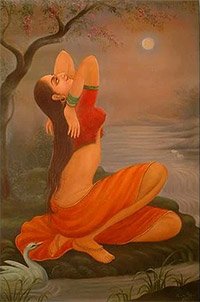Ratirahasya, Rati-rahasya: 8 definitions
Introduction:
Ratirahasya means something in Hinduism, Sanskrit. If you want to know the exact meaning, history, etymology or English translation of this term then check out the descriptions on this page. Add your comment or reference to a book if you want to contribute to this summary article.
In Hinduism
Ayurveda (science of life)
Source: academia.edu: Tessitori Collection I (ayurveda)Ratirahasya (रतिरहस्य) is another name for Kokaśāstra, which was rendered in Hindi by Ānanda Kavi as the Kokasāra (dealing with Poetics and Erotics), which is included in the collection of manuscripts at the ‘Vincenzo Joppi’ library, collected by Luigi Pio Tessitori during his visit to Rajasthan between 1914 and 1919.—The Kokasāra is a hindi rewriting of the Kokaśāstra (Kokkaśāstra) alias Ratirahasya, a famous Sanskrit work of the Kāmaśāstra tradition which is characterized, in particular, by the division of ladies in four categories related to their body-marks, namely padminī, citraṇī, śaṅkhanī and hastinī, with which the work starts. It is very popular and known as Kokasāra (as the author names it) or Kokamañjarī.

Āyurveda (आयुर्वेद, ayurveda) is a branch of Indian science dealing with medicine, herbalism, taxology, anatomy, surgery, alchemy and related topics. Traditional practice of Āyurveda in ancient India dates back to at least the first millenium BC. Literature is commonly written in Sanskrit using various poetic metres.
Kama-shastra (the science of Love-making)
Source: Wikipedia: KāmaśāstraRatirahasya (रतिरहस्य) (also known as the Kokaśāstra) is the name of a a medieval Indian sex manual written by Kokkoka—a poet variously described as Koka or Koka Pundit (Kokapaṇḍita). The exact date of its writing is not known, but it is estimated the text was written in the 11th or 12th century. It is speculated that Ratirahasya was written to please a king by the name Venudutta. Kokkoka describes himself in the book as siddha patiya pandita, i.e. "an ingenious man among learned men". The manual was written in Sanskrit.
Source: Shodhganga: Influence of Kamasastra on classical Sanskrit literatureRatirahasya (रतिरहस्य) is the name of a text dealing with Kāmaśāstra as referenced by the Kelikutuhala by Pandita Mathura Prasada Dixit—The Kelikutūhala is a recent erotic book written in 1949 A.D. discussing topics such as masturbation, use of medicines, coital postures, prostitution, etc.. In the introduction to this book the author gives a list 64 of fifty books [e.g., ratirahasya] which were written on erotic science in which most of the books are unpublished. All these books show the rich heritage of Indian erotic science (kāma-śāstra).

Kamashastra (कामशास्त्र, kāmaśāstra) deals with ancient Indian science of love-making, passion, emotions and other related topics dealing with the pleasures of the senses.
Languages of India and abroad
Sanskrit dictionary
Source: DDSA: The practical Sanskrit-English dictionaryRatirahasya (रतिरहस्य).—Name of an erotic work by Kokkoka.
Derivable forms: ratirahasyam (रतिरहस्यम्).
Ratirahasya is a Sanskrit compound consisting of the terms rati and rahasya (रहस्य).
Source: Cologne Digital Sanskrit Dictionaries: Aufrecht Catalogus Catalogorum1) Ratirahasya (रतिरहस्य) as mentioned in Aufrecht’s Catalogus Catalogorum:—kāmaśāstra, written for Vaiṇyadatta by Kokkoka. Io. 1834. 2118. K. 248. B. 3, 52. 54. Burnell. 58^b. Bhr. 214. Poona. Ii, 92. Oppert. 148. 1021. 2004. 2416. 2976. 5143. 5620. 5928. 6985. 7376. Ii, 4123. 6139. Quoted frequently by Mallinātha, by Śivarāma on Vāsavadattā p. 146.
—[commentary] Oppert. 6160. 8200. Ii, 6692.
—[commentary] by Kāñcīnātha. Io. 3250. Burnell. 59^a. Gu. 5. Taylor. 1, 343.
2) Ratirahasya (रतिरहस्य):—by Vidyādhara (?). Oudh. Viii, 20.
—by Harihara. Taylor. 1, 87.
3) Ratirahasya (रतिरहस्य):—kāmaśāstra, written for Vainyadatta by Kokkoka. [Bhau Dāji Memorial] 24. 131. Bl. 250 (10^th chapter: Yogādhyāya). Gov. Or. Libr. Madras 74. Peters. 4, 29.
—[commentary] by Kāñcīnātha. Gov. Or. Libr. Madras 74.
—[commentary] by Rāmacandra Sūri. ibid.
4) Ratirahasya (रतिरहस्य):—by Kokkoka. Bc 470. L.. 852. Whish 45. C. by Gopāla, son of Sukhadhara. L.. 853 ([fragmentary]).
Source: Cologne Digital Sanskrit Dictionaries: Monier-Williams Sanskrit-English DictionaryRatirahasya (रतिरहस्य):—[=rati-rahasya] [from rati > ram] n. ‘mysteries of love’, Name of an erotic [work] by Kokkoka
[Sanskrit to German]
Sanskrit, also spelled संस्कृतम् (saṃskṛtam), is an ancient language of India commonly seen as the grandmother of the Indo-European language family (even English!). Closely allied with Prakrit and Pali, Sanskrit is more exhaustive in both grammar and terms and has the most extensive collection of literature in the world, greatly surpassing its sister-languages Greek and Latin.
See also (Relevant definitions)
Partial matches: Rahasya, Rati.
Starts with: Ratirahasyadipika, Ratirahasyarnava.
Query error!
Full-text: Ratirahasyadipika, Kokkoka, Kokkvoka, Kokashastra, Kukkoka, Vainyadatta, Srashta, Koka, Kokapandita, Ratirahasyarnava, Vidyadhara kavi, Shitkar, Kokasara, Kokamanjari, Kokkashastra, Harihara, Murchana.
Relevant text
Search found 12 books and stories containing Ratirahasya, Rati-rahasya; (plurals include: Ratirahasyas, rahasyas). You can also click to the full overview containing English textual excerpts. Below are direct links for the most relevant articles:
Kamashastra Discourse (Life in Ancient India) (by Nidheesh Kannan B.)
2. Works on Kāmaśāstra (a): Ratirahasya < [Chapter 2 - An Appraisal of Kāmaśāstra Works in Sanskrit]
2. Works on Kāmaśāstra (j): Śṛṅgārarasaprabandhadīpikā < [Chapter 2 - An Appraisal of Kāmaśāstra Works in Sanskrit]
2. Works on Kāmaśāstra (e): Ratiratnapradīpikā < [Chapter 2 - An Appraisal of Kāmaśāstra Works in Sanskrit]
Journal of the European Ayurvedic Society (by Inge Wezler)
Kokkoka’s Ratirahasya translated and explained (Part 1) < [Volume 3 (1993)]
Kokkoka’s Ratirahasya translation (Part 3) < [Volume 5 (1997)]
Kokkoka’s Ratirahasya translation (Part 2) < [Volume 4 (1995)]
Exploring Indian Love Arts: Translations of Ratirahasya and Anaṅgaraṅga < [Volume 71 (2010)]
Hastalaksanadipika a critical edition and study (by E. K. Sudha)
2. Authorship and Antiquity of the Abhinaya-darpana < [Chapter 3 - Later developments of dramatic techniques]
Kamashastra and Classical Sanskrit literature (study) (by Vishwanath K. Hampiholi)
Chapter 5.5-6 - Regarding the lust of Rulers and Women of the Royal Harem < [Chapter 6 - Kamasutra part 5 (Para-darika-adhikarana )—Critical study]
Chapter 1.1 - Preface and History of Erotic Science < [Chapter 2 - Kamasutra part 1 (Sadharana-adhikarana)—Critical study]
Glories of India (Culture and Civilization) (by Prasanna Kumar Acharya)
Knowledge of Eugenics (Kama-shastra) < [Chapter 6 - Practical sciences]